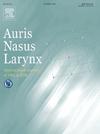Phonosurgery for vocal fold polyps: A comprehensive analysis of multidimensional voice outcomes in 201 cases and the impact of polyp size
IF 1.5
4区 医学
Q2 OTORHINOLARYNGOLOGY
引用次数: 0
Abstract
Objective
To elucidate the clinical characteristics of vocal fold polyps (VFPs) and evaluate the efficacy of phonosurgery using a comprehensive analysis of multidimensional voice parameters.
Methods
We conducted a retrospective review of 201 patients with VFPs treated at Kurume University Hospital between 1996 and 2022. All patients underwent either endolaryngeal microsurgery (LMS) under general anesthesia or forceps excision (FE) under local anesthesia. Lesions were categorized as pedunculated or sessile and as hemorrhagic or non-hemorrhagic based on coloration. Polyp size was calculated as the ratio of the lesion diameter to the distance from the anterior commissure to the vocal process. Pre- and postoperative values and postoperative differences (Δ) were analyzed for voice parameters: maximum phonation time (MPT), mean flow rate (MFR), fundamental frequency (Fo), Fo range, sound pressure level (SPL), SPL range, pitch perturbation quotient (PPQ), amplitude perturbation quotient (APQ), jitter, shimmer, normalized noise energy (NNEa), noise-to-harmonic ratio, Voice Handicap Index-10 (VHI-10), Voice-Related Quality of Life (V-RQOL), and GRB scale (G = grade, R = roughness, B = breathiness). Outcomes between LMS and FE were compared using adjusted analyses to control for baseline differences.
Results
Men were significantly older than women (p = 0.034) and had larger polyps (p = 0.005) that were more often pedunculated (p = 0.006) and hemorrhagic (p = 0.031); bilateral lesions were more common in women (p = 0.040). Except for Fo and SPL, all multidimensional voice parameters improved significantly after surgery. Comparing surgical approaches, the LMS group (n = 166) was younger (p = 0.003) and had larger polyps (p < 0.001) than the FE group (n = 35). After adjusting for age and polyp size, most voice parameters showed no significant difference between LMS and FE. Polyp size was weakly to moderately correlated with multiple preoperative parameters; it correlated positively with MFR in men (p = 0.025), PPQ (p = 0.032), APQ (p = 0.003), jitter (p = 0.027), shimmer (p = 0.001), NNEa (p = 0.004), VHI‑10 (p = 0.030), G (p = 0.001), R (p = 0.006), and B (p = 0.006) and negatively with MPT (p = 0.012) and Fo range in men (p = 0.015). Larger polyps also showed weak negative correlations with ΔAPQ (p = 0.029), Δjitter (p = 0.009), Δshimmer (p = 0.047), ΔVHI-10 (p = 0.037), ΔG (p = 0.005), ΔR (p = 0.031), and ΔB (p = 0.005).
Conclusion
Phonosurgery for VFPs significantly improves multidimensional voice outcomes. Polyp size is a contributing factor to the degree of preoperative vocal impairment and the magnitude of postoperative recovery. After adjustment, FE provided comparable voice outcomes to LMS, confirming its role as a valuable therapeutic alternative for patients who are not candidates for LMS.
声带息肉的声学手术:201例患者的多维语音预后及息肉大小的影响的综合分析
目的通过对声带息肉(VFPs)的多维声参数的综合分析,探讨声带手术的临床特点,评价其疗效。方法回顾性分析1996年至2022年在库鲁姆大学医院治疗的201例vfp患者。所有患者均在全麻下行咽内显微手术(LMS)或局部麻醉下行产钳切除(FE)。病变根据颜色分为带梗或无梗,出血性或非出血性。息肉大小计算为病变直径与前连合到声带突的距离之比。分析语音参数术前、术后值及术后差异(Δ):最大发声时间(MPT)、平均流速(MFR)、基频(Fo)、Fo范围、声压级(SPL)、SPL范围、音高摄动商(PPQ)、幅度摄动商(APQ)、抖动、闪烁、标准化噪声能量(NNEa)、噪声谐波比、语音障碍指数-10 (VHI-10)、语音相关生活质量(V-RQOL)、GRB量表(G =等级,R =粗糙度,B =呼吸度)。LMS和FE之间的结果采用校正分析进行比较,以控制基线差异。结果男性年龄明显大于女性(p = 0.034),息肉较大(p = 0.005),息肉带梗(p = 0.006)和出血(p = 0.031)较多;双侧病变在女性中更为常见(p = 0.040)。除Fo和SPL外,术后各多维语音参数均有明显改善。与手术入路比较,LMS组(n = 166)比FE组(n = 35)更年轻(p = 0.003),息肉更大(p < 0.001)。在调整年龄和息肉大小后,大多数语音参数在LMS和FE之间没有显着差异。息肉大小与术前多项参数呈弱至中度相关;与男性MFR (p = 0.025)、PPQ (p = 0.032)、APQ (p = 0.003)、jitter (p = 0.027)、shimmer (p = 0.001)、NNEa (p = 0.004)、VHI - 10 (p = 0.030)、G (p = 0.001)、R (p = 0.006)、B (p = 0.006)呈正相关,与男性MPT (p = 0.012)、Fo range (p = 0.015)呈负相关。较大息肉与ΔAPQ (p = 0.029)、Δjitter (p = 0.009)、Δshimmer (p = 0.047)、ΔVHI-10 (p = 0.037)、ΔG (p = 0.005)、ΔR (p = 0.031)和ΔB (p = 0.005)也呈弱负相关。结论声道手术治疗vfp可显著改善患者的多维语音预后。息肉大小是术前声带损伤程度和术后恢复程度的一个重要因素。调整后,FE提供了与LMS相当的语音结果,证实了其作为非LMS候选患者的有价值的治疗选择的作用。
本文章由计算机程序翻译,如有差异,请以英文原文为准。
求助全文
约1分钟内获得全文
求助全文
来源期刊

Auris Nasus Larynx
医学-耳鼻喉科学
CiteScore
3.40
自引率
5.90%
发文量
169
审稿时长
30 days
期刊介绍:
The international journal Auris Nasus Larynx provides the opportunity for rapid, carefully reviewed publications concerning the fundamental and clinical aspects of otorhinolaryngology and related fields. This includes otology, neurotology, bronchoesophagology, laryngology, rhinology, allergology, head and neck medicine and oncologic surgery, maxillofacial and plastic surgery, audiology, speech science.
Original papers, short communications and original case reports can be submitted. Reviews on recent developments are invited regularly and Letters to the Editor commenting on papers or any aspect of Auris Nasus Larynx are welcomed.
Founded in 1973 and previously published by the Society for Promotion of International Otorhinolaryngology, the journal is now the official English-language journal of the Oto-Rhino-Laryngological Society of Japan, Inc. The aim of its new international Editorial Board is to make Auris Nasus Larynx an international forum for high quality research and clinical sciences.
 求助内容:
求助内容: 应助结果提醒方式:
应助结果提醒方式:


